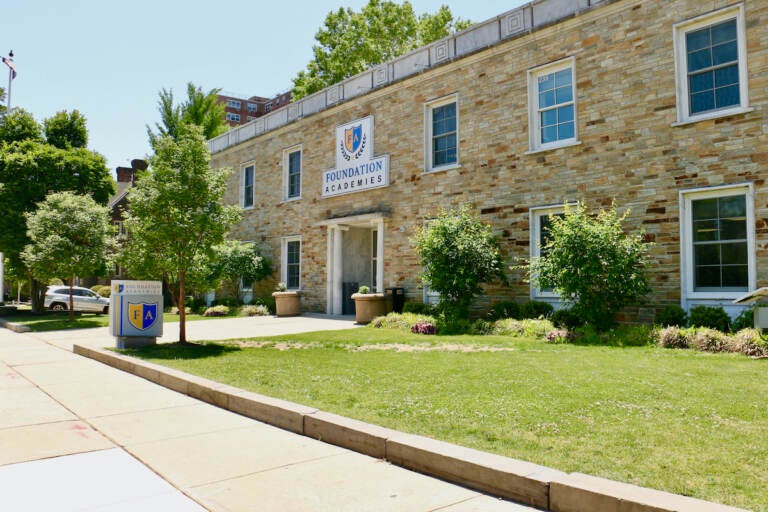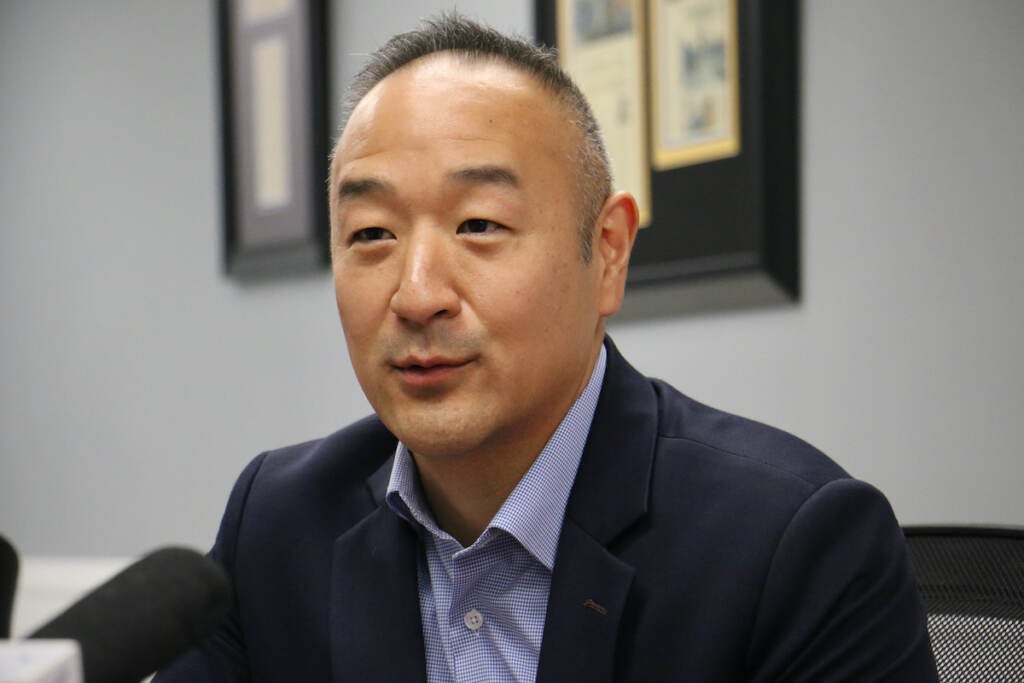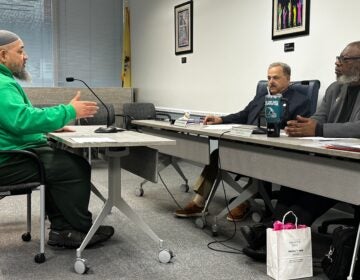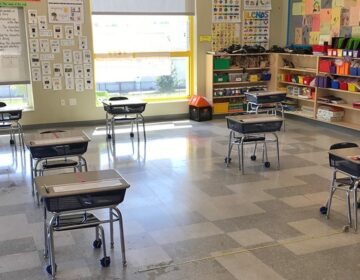New Jersey charter schools seek equal treatment to fund their buildings
Charter schools are public schools in the Garden State, except when it comes to funding buildings.
Listen 5:36
Foundation Academies is one of the most sought after schools in Trenton, according to N.J. Charter Schools Association President Harry Lee. (Emma Lee/WHYY)
If a pipe bursts at one of the two locations that Foundation Academies operates in Trenton, they will have to pay for it.
“We do budget for those types of emergencies,” said Andre’ Moore, chief operating and financial officer of the charter school.
The school is also responsible for larger building needs such as a roof replacement or classroom renovations.
They get no help from the state.
New Jersey law prevents charter schools such as Foundation Academies from accessing state funds to address capital needs.
Moore said the situation is “frustrating and unfair” because the money they currently receive could be allocated to enhance the education of their students, which the school refers to as “scholars.”
Foundation Academies operates a K-8 school off West State Street and a high school on Grand Avenue. Across both campuses, it has approximately $15 million in facility needs, including roof replacements. Almost a third of that amount is needed to address immediate concerns.
Moore said they’ve tried to raise money to address building needs, but it’s an uphill challenge.
“The donor community aren’t really excited about funding the buildings,” he said. “Normally, their first priorities are some of our scholarships, backpack funds, [and] supplies.”
In addition to a roof, which has been patched up several times, the school’s building on West State Street needs a new fire pump, which costs $50,000. Moore said many parts aren’t available for the current pump in the basement, which is leaking.
There is also a fence along the west side of the property that needs to be replaced. It costs at least $115,000 and does not include removing a tree that is in the middle of the fence’s path.
Foundation Academies CEO Sheria McRae said all students deserve quality facilities, regardless of whether it’s a public, charter, or private school.
“It should be seen that we need equitable facilities funding and we should be provided with that opportunity and access,” said McRae, arguing the money being used to address building needs is taking away from a learning resource they would otherwise purchase for their students.
“It should not be our reality that we’re doing more with less,” she added.
Where the money comes from
Money for New Jersey’s 91 charter schools comes from the state. It is transferred to the local school district where the charter is located. The district keeps 10% of the money to cover transportation and other costs before passing on the rest to the charter school.
For Foundation Academies that translates to the school receiving about $5,000 less per student, according to Harry Lee, president of the New Jersey Public Charter Schools Association. He adds that is one funding gap, in addition to the larger one regarding facilities.
“This school and every other charter school across the state has to use operating funds for about 10% of their budget on facilities,” he said.

A bill in the Legislature, sponsored by Assembly Speaker Craig Coughlin, seeks to provide a lane for charter and renaissance schools to get funding for buildings. Assembly Bill 4496 would allow charter and renaissance schools to compete for a portion of the school construction budget from the state.
He said the bill would create a fund specifically for traditional public schools in School Development Authority or SDA districts. Charter, renaissance, and traditional public schools in non-SDA districts would compete over whatever funds are left.
SDA districts were once called Abbott districts, named after the court case that found that the state’s funding law for education was unconstitutional. A series of decisions have been implemented in the decades since the case was brought in the 1980s with the goal of putting the state’s 31 poorest school districts on par with wealthier ones.
“I think [the bill] recognizes that there are a considerable number of students in New Jersey who attend charter schools and they deserve quality facilities as well,” said Coughlin.
But, the legal advocacy group Education Law Center, which has provided legal counsel for plaintiffs in the Abbott case, has opposed the bill.
Theresa Luhm, managing director of the center, said the state’s first obligation is to students in traditional public schools, where there is a backlog of building needs.
“We know that even beyond what is being currently spent on school construction, there’s at least another $7 billion needed to meet both the capacity needs and the building remediation in those former Abbott school districts,” she added.
Luhm said one of their main concerns about the speaker’s proposal is that public money would go to fund private property owners.
“Charter schools are housed in private buildings, buildings owned by private companies,” she said. “If those charter schools close, that money or those renovations would revert to whoever owns the property, which we don’t think is a great way to spend taxpayer dollars.”
But the charter school association argues that students who are placed in charter schools are still public school students. It’s also the case Charlottee Tullo made in support of the proposal.
“Why can’t you equally fund a safe, healthy environment for all these kids to learn in,” she asked.
Tullo, a native Texan, took full custody of her three grandchildren before moving to New Jersey. She moved them to Foundation Academies from the Trenton Public School district, after hearing about the school at church. She felt the resources would be better there for her grandkids, who have special needs.
“My granddaughter who graduated in 2020 had an auditory issue,” she said. “I had been trying to get her tested through my traditional public school and wasn’t able to do that.”
When her granddaughter began attending Foundation, she was tested right away, and a curriculum was adapted towards her learning style, Tullo said. Another curriculum was customized for another grandchild who is high-functioning autistic.
Tullo said she became aware of the funding disparities between charter and traditional public schools when she became a parent liaison for Foundation Academies.
“As a taxpaying parent, I just feel like they’re so wrong because they’re all public school kids,” she said. “It’s really strange to me how they separate the two.”
Everyone but New Jersey
New Jersey, along with Oregon and Pennsylvania, is one of three states where charter schools do not have access to money to address their building needs.
“It’s quite common for states with charter school laws to provide at least some access to capital funds,” said Robin Lake, director of the Center on Reinventing Public Education at Arizona State University, adding that each state addresses the issue differently. “They’ll often take an equity lens to that question and say charter schools operating in higher needs areas have higher priority for those capital funds.”
The New Jersey Public Charter School Association says 90% of the state’s charter school students are in SDA districts. The vast majority of them are students of color and 77% of students, overall, qualify for free or reduced-price lunch.
“These are the same kids with the same needs in these communities [as] their friends, their neighbors, in many cases, they’re siblings of the student that attends [a traditional public school,]” said Harry Lee. “We should be treating every kid fairly.”
The association conducted a survey of facility needs among charter and renaissance schools across the state. Three renaissance and 58 charter schools responded to the survey. The results indicated that $900 million is needed to address their building concerns over the next decade.
That report is the basis of the association’s “Same Kids, Same Needs” social media campaign to get Speaker Coughlin’s bill passed. An Assembly committee voted to send the bill to the full chamber in February, where it is currently awaiting a discussion and vote.
Lee said the bill provides a framework that would allow charter schools to “actually stand in line” for capital funding.
“In future discussions, the legislature is going to allocate what they can allocate on facilities funding,” he said. “We want to be part of that conversation.”
Luhm, with the Education Law Center, suggests the state Department of Education be “a little more rigorous in approving facilities for charter schools.”
“Perhaps at the beginning of the process that should be vetted more so we don’t end up having to put public money to fund property that’s owned by private entities,” she said.

Get daily updates from WHYY News!
WHYY is your source for fact-based, in-depth journalism and information. As a nonprofit organization, we rely on financial support from readers like you. Please give today.







